Related Research Articles
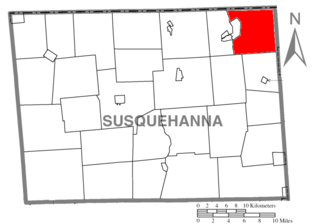
Harmony Township is a township in Susquehanna County, Pennsylvania, United States. The population was 512 at the 2020 census.

According to Latter Day Saint belief, the golden plates are the source from which Joseph Smith translated the Book of Mormon, a sacred text of the faith. Some accounts from people who reported handling the plates describe the plates as weighing from 30 to 60 pounds, gold in color, and composed of thin metallic pages engraved with hieroglyphics on both sides and bound with three D-shaped rings.
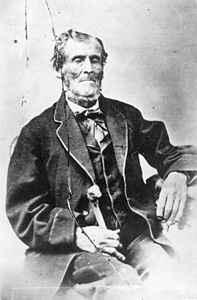
Martin Harris was an early convert to the Latter Day Saint movement who financially guaranteed the first printing of the Book of Mormon and also served as one of Three Witnesses who testified that they had seen the golden plates from which Joseph Smith said the Book of Mormon had been translated.
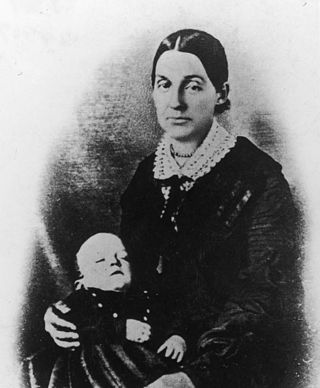
Emma Hale Smith Bidamon was a leader in the early Latter Day Saint movement and a prominent member of the Reorganized Church of Jesus Christ of Latter Day Saints as well as the first wife of Joseph Smith, the movement's founder. In 1842, when the Ladies' Relief Society of Nauvoo was formed as a women's service organization, she was elected by its members as the organization's first president.

According to Latter Day Saint theology, seer stones were used by Joseph Smith, as well as ancient prophets, to receive revelations from God. Members of the Church of Jesus Christ of Latter-day Saints believe that Smith used seer stones to translate the Book of Mormon.
Mary Elsa Musselman Whitmer was a Book of Mormon witness and the wife of Peter Whitmer Sr.

The Eight Witnesses were one of the two groups of witnesses who made statements stating that they had seen the golden plates which Joseph Smith said was his source material for the Book of Mormon. An earlier group of witnesses who said they had seen the plates were called the Three Witnesses.

The "lost 116 pages" were the original manuscript pages of what Joseph Smith, founder of the Latter Day Saint movement, said was the translation of the Book of Lehi, the first portion of the golden plates revealed to him by an angel in 1827. These pages, which had not been copied, were lost by Smith's scribe, Martin Harris, during the summer of 1828 and are presumed to have been destroyed. Smith completed the Book of Mormon without retranslating the Book of Lehi, replacing it with what he said was an abridgment taken from the Plates of Nephi.
Hiram Page was an early member of the Latter Day Saint movement and one of the Eight Witnesses to the Book of Mormon's golden plates.
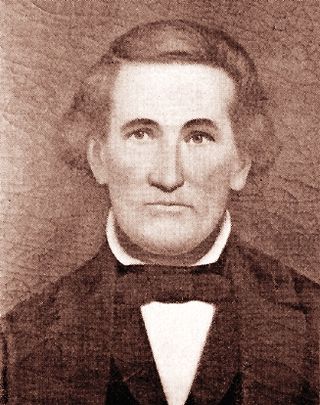
Jacob Whitmer was the second born child of Peter Whitmer, Sr., and Mary Musselman. He is primarily remembered as one of the Eight Witnesses of the Book of Mormon’s golden plates.
Joseph Smith was an American religious leader and the founder of the Latter Day Saint movement whose current followers include members of the Church of Jesus Christ of Latter-day Saints, the Community of Christ, and other Latter Day Saint denominations. The early life of Joseph Smith covers his life from his birth to the end of 1827.
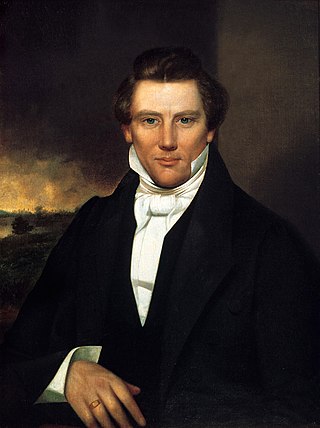
The life of Joseph Smith from 1827 to 1830, when he was 22–25 years old, begins in late 1827, after Smith announced he had obtained a book of golden Plates buried in a hill near his home in Manchester, New York. Because of opposition by former treasure-seeking colleagues who believed they owned a share of the golden plates, Smith prepared to leave the Palmyra area for his wife's home town of Harmony, Pennsylvania. From late 1827 to the end of 1830, Smith wrote and published the Book of Mormon, and established the Church of Christ.
Joseph Knight Sr. was a close associate of Joseph Smith, founder of the Latter Day Saint movement. Knight provided significant material support to Smith's translation and publication of the Book of Mormon.

The Book of Mormon witnesses were a group of contemporaries of Joseph Smith who claimed to have seen the golden plates from which Smith translated the Book of Mormon. The most significant witnesses were the Three Witnesses and the Eight Witnesses, all of whom allowed their names to be used on two separate statements included with the Book of Mormon and church leaders contend that the witnesses never denied their accounts. Critics have challenged the nature and reliability of the accounts, as eyewitness testimony is increasingly known to be unreliable.

Adherents to the Latter Day Saint movement view the Book of Mormon as a work of divinely inspired scripture, which was written by ancient prophets in the ancient Americas. Most adherents believe Joseph Smith's account of translating ancient golden plates inscribed by prophets. Smith preached that the angel Moroni, a prophet in the Book of Mormon, directed him in the 1820s to a hill near his home in Palmyra, New York, where the plates were buried. An often repeated and upheld as convincing claim by adherents that the story is true is that besides Smith himself, there were at least 11 witnesses who said they saw the plates in 1829, three that claimed to also have been visited by an angel, and other witnesses who observed Smith dictating parts of the text that eventually became the Book of Mormon.

The children of Joseph Smith Jr., the founder of the Latter Day Saint movement, and his wife Emma Smith, are historically significant because of their roles in establishing and leading the Latter Day Saint Movement, which includes the Church of Jesus Christ of Latter-day Saints, the Reorganized Church of Jesus Christ of Latter Day Saints, The Church of Jesus Christ (Bickertonite), the Church of Christ and several other sects. Some Latter Day Saint sects, including the RLDS, believed that leadership of the church would follow lineal succession of Smith's descendants. In 1860, Joseph Smith III became the prophet and president of the RLDS Church, succeeded by his sons. The Community of Christ no longer holds to this practice. The larger LDS Church did not follow the practice, and it was led after Joseph Smith's death by Brigham Young.

This is a chronology of Mormonism. In the late 1820s, Joseph Smith, founder of the Latter Day Saint movement, announced that an angel had given him a set of golden plates engraved with a chronicle of ancient American peoples, which he had a unique gift to translate. In 1830, he published the resulting narratives as the Book of Mormon and founded the Church of Christ in western New York, claiming it to be a restoration of early Christianity.

Joseph Smith Jr. was an American religious leader and the founder of Mormonism and the Latter Day Saint movement. Publishing the Book of Mormon at the age of 24, Smith attracted tens of thousands of followers by the time of his death fourteen years later. The religion he founded is followed to the present day by millions of global adherents and several churches, the largest of which is the Church of Jesus Christ of Latter-day Saints.
Samuel Tyler Lawrence was resident of New York in the 1820s who was an early associate of Joseph Smith, the founder of the Latter-day Saint movement. Lawrence moved from New Jersey to Palmyra, New York, with sister Fanny and her husband Abner Cole. Lawrence and Smith reportedly engaged in "money-digging".

Cunning folk traditions, sometimes referred to as folk magic, were intertwined with the early culture and practice of the Latter Day Saint movement. These traditions were widespread in unorganized religion in the parts of Europe and America where the Latter Day Saint movement began in the 1820s and 1830s. Practices of the culture included folk healing, folk medicine, folk magic, and divination, remnants of which have been incorporated or rejected to varying degrees into the liturgy, culture, and practice of modern Latter Day Saints.
References
- 1 2 3 4 5 6 7 8 9 10 11 "Josiah Stowell Biography". www.josephsmithpapers.org. Retrieved 2024-09-22.
- 1 2 "The Josiah Stowell Jr.-John S. Fullmer Correspondence" (PDF). mormonpolygamydocuments.org.
- ↑ Bushman, Richard Lyman (March 13, 2007). Joseph Smith: Rough Stone Rolling. Knopf Doubleday Publishing Group. ISBN 978-1-4000-7753-3 – via Google Books.
- ↑ "During the time that I was thus employed, I was put to board with a Mr. Isaac Hale, of that place; it was there I first saw my wife (his daughter), Emma Hale. On the 18th of January, 1827, we were married, while I was yet employed in the service of Mr. Stoal."
- ↑ Whitmer, David (September 12, 1887). "An address to all believers in Christ". Richmond, Missouri David Whitmer – via Internet Archive.